Overview
Blueberries are a major crop for the state of Georgia, generating about $449 million in farm gate value (Farm Gate Value Report, 2024). The main types of blueberries cultivated in the state are southern highbush (Vaccinium corymbosum interspecific hybrids) and rabbiteye (Vaccinium virgatum). The blueberry season in Georgia typically starts in late March with the harvest of southern highbush berries and finishes in July with the harvest of rabbiteye blueberries.
Blueberry fruit set, development, and ripening are influenced by external and internal factors. These include adverse weather conditions, poor pollination, and varietal genetic makeup—all playing an important role from bloom to fruit set and throughout the fruit ripening process. The increase or decrease in temperature during bloom, fruit set, and ripening can potentially lead to poor fruit quality or a delayed harvest.
Temperature affects pollination, ovule fertilization, and pollen viability, and thus is by far the most relevant factor during blueberry fruit development processes. The genetic makeup of a variety also contributes to fruit quality. High-yielding blueberry varieties like ‘Brightwell’ tend to produce more fruit than vegetative tissue, which can cause an unbalanced shoot-to-fruit ratio. When this happens, there is not enough carbohydrate supply and fruits tend to be of smaller size, have lower sugars, or have an incomplete ripening pattern.
This publication will inform growers about the factors that can affect blueberry fruit set, development, and ripening. As erratic weather patterns become more prevalent, it is important to keep in mind that environmental factors influence plants’ physiological and developmental processes and understand how that translates into fruit quality each harvest season.
Blueberry Fruit Developmental Stages
Fruit Set
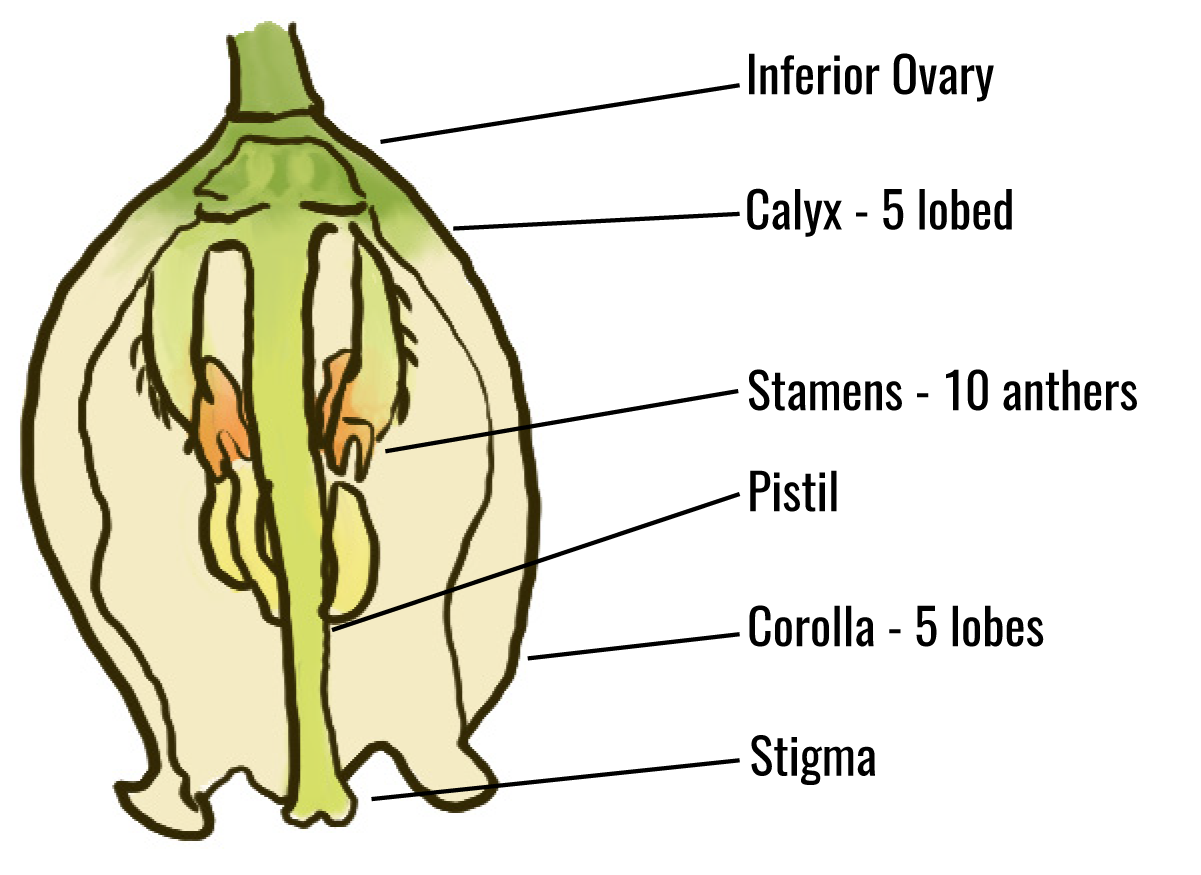
Fruit set mainly depends on pollination, which also is where fruit and seed development begins. If pollination is delayed, the percentage of fruit set in blueberry plants declines sharply. Highbush flowers are open for about 5–8 days, while rabbiteye flowers are open for approximately 5–6 days, allowing for pollination to occur during that period.
The number of seeds in the fruit significantly influences fruit size and depends on the percentage of cross-pollination that has occurred. Therefore, pollination is a crucial factor in ensuring adequate fruit set, berry weight, and proper ripening. While the number of seeds is crucial for determining fruit size, other factors such as pollinator activity, air temperature, crop load, and water availability account for more than 50% of the variation in fruit size.
Fruit Growth and Development
Blueberries have three growth stages; their growth pattern follows a double sigmoidal (S-curve) growth curve (Figure 2).
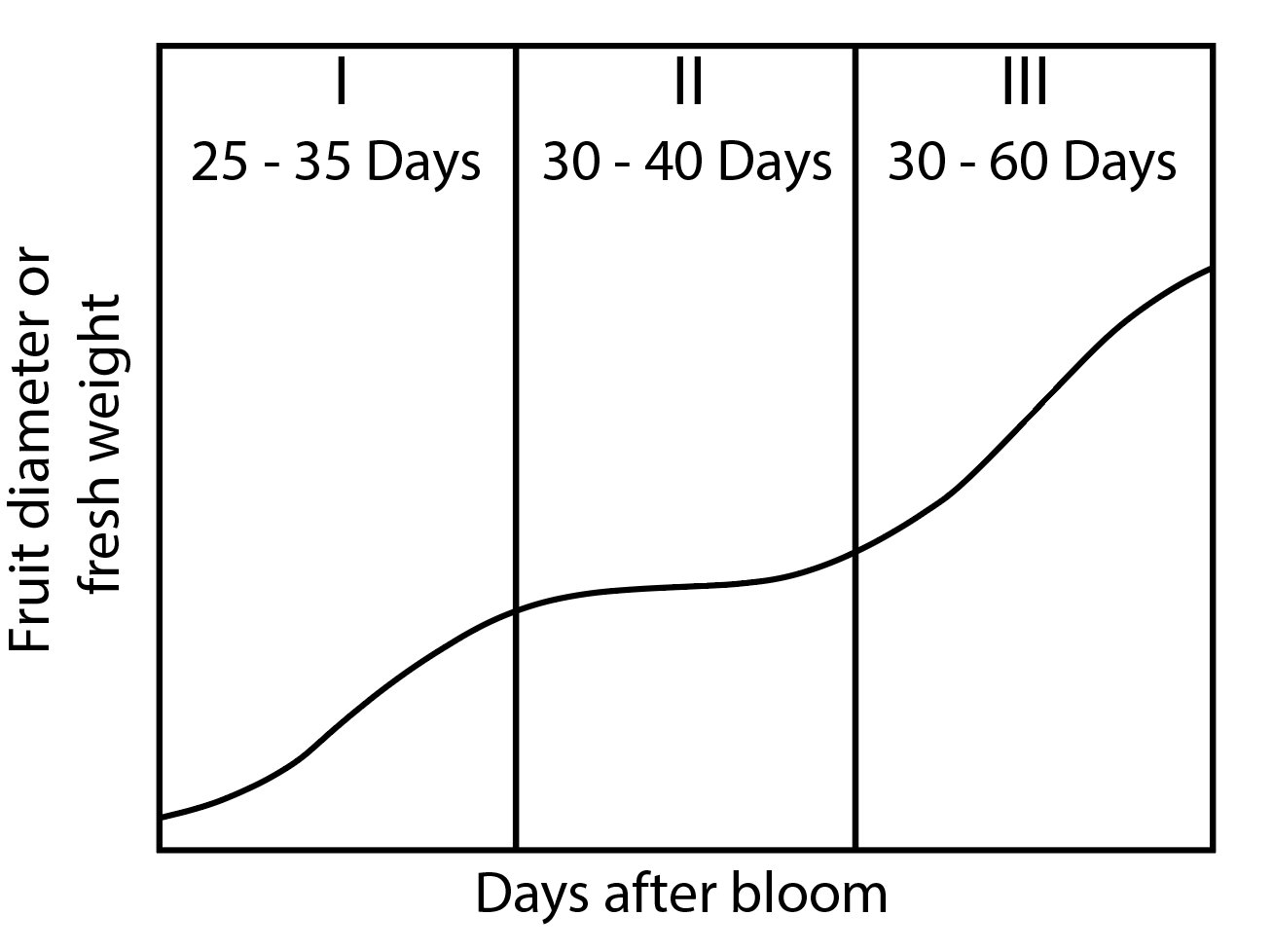
First stage: Depending on the variety and environmental factors, this stage lasts 25 to 35 days after bloom and is characterized by high rates of cell division and dry weight gain.
Second stage: During this stage, fruits show minimal growth, but this is an active time for seed development and hardening. Stage II can last anywhere from 30 to 40 days after bloom, depending on the variety, environmental factors, and the quantity of viable seeds. Highbush varieties typically have a shorter Stage II than rabbiteye varieties.
Third stage: This stage is distinguishable from the other two stages in that it exhibits extremely quick fruit growth caused by cell expansion. Stage III lasts around 30 to 60 days after bloom. During Stage III, anthocyanins accumulate and berries transform from green to blue. For southern highbush plants, fruit development lasts 55 to 60 days after bloom, and for rabbiteye plants, 60 to 135 days after bloom (depending upon the variety).
Fruit Ripening

Fruit ripening begins toward the end of Stage III and is greatly affected by temperature. During fruit ripening, the acidity content of the fruits decreases while the sugar content increases. Fruits also start to soften. Blueberry fruit clusters do not ripen all at once. During fruit ripening, berries with different colors—green, pink, and blue shades—can be seen in the same cluster (Figure 4).
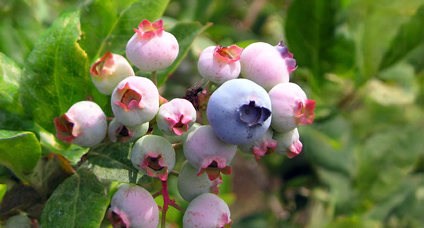
Blueberry fruit development and ripening processes usually take around 45 to 90 days, depending on the variety and environmental factors. Blueberry fruit quality does not improve after harvest. Fruit ripening is a highly coordinated biochemical process that involves changes in fruit texture, color, flavor, and susceptibility to biotic and abiotic factors. Three seed-derived hormones—ethylene, abscisic acid (ABA), and auxins—and their crosstalk (interactions) influence fruit ripening. Environmental and genetic factors influence these three seed-derived plant hormones.
In blueberries, seed development and fruit development occur after pollination, culminating in fruit ripening. In addition, fruits typically are classified as climacteric or nonclimacteric fruits depending on respiration and ethylene levels during ripening. In climacteric fruits, the respiration rate increases during fruit ripening, and ethylene is a primary driver of ripening-related changes. In nonclimacteric fruits, dramatic increases in respiration and ethylene are not discernable. The distinctions between climacteric and nonclimacteric fruits are currently fading with research showing that ethylene influences certain ripening aspects in nonclimacteric fruits.
Blueberry fruit exhibits an increase in respiration and ethylene production, suggesting a climacteric ripening physiology. However, unlike typical climacteric fruits, ethylene production in blueberry fruit is not autocatalytic (when the reaction product, in this case ethylene, also acts as a catalyst for its formation) in terms of its biosynthesis, but it appears to be more developmentally regulated. Thus, fruit set, development, and ripening can be hindered by numerous environmental factors and intrinsic factors that may affect fruit quality.
External Factors Affecting Fruit Set, Development and Ripening
Temperature
Temperature affects plants’ biological processes. Blueberry plants will not grow at temperatures below 38 °F, and higher temperatures—around 46–68 °F—stimulate plant growth and fruit ripening. Photosynthetic rates are reduced under high temperatures and carbohydrate accumulation in the fruit is reduced, which affects the total soluble solids content. As such, high temperatures directly affect fruit quality, and the rate of fruit softening also increases at high temperatures, reducing fruit firmness. In contrast, nighttime temperatures below 50 °F can greatly slow the rate of fruit development. Additionally, warm temperatures during the fall and winter shift blueberry plants’ phenological stage, making the plants more susceptible to spring freezes. Warm night temperatures of around 70 °F can hinder fruit set, development, and fruit size. Pollination (e.g., bee visitation) is reduced at 50 °F or lower. Fruit quality and the rate of fruit ripening are slow under shading since shading decreases temperatures by about 5 °F. Temperatures during the day of 84 °F or higher can decrease final fruit size and inhibit fruit development.
Frost and freeze damage
Late winter or early spring freezes are very common in the southeastern areas of the United States and can severely damage blueberry floral, fruit, and seed development (Figure 5). Fruit development can be damaged below 30.2 °F. During freeze events, different parts of the flower may also be damaged. Thus, low temperatures can reduce both pollination and fruit set.
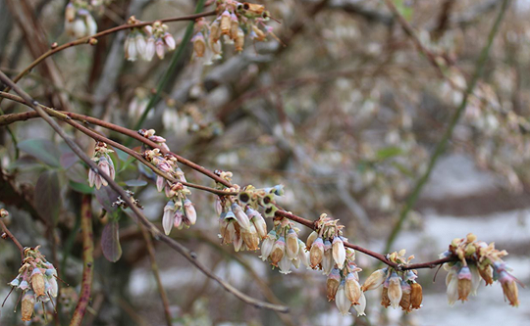
Flower damage may not always be visible. In some cases, the stigma and style can be damaged, but the corollas do not always show visible damage. If the ovules are damaged but fruit is set later on, these berries will not develop viable seeds and the berries will be aborted. Seed development is also compromised during freeze events. Blueberry fruit injured at Stage II of development (seed hardening) will turn brown and will not abscise (fall off). A cold front could inhibit ripening if night temperatures drop to levels lower than 50 °F.
Internal Factors That Affect Fruit Set, Development and Ripening
Pollination
Poor pollination in rabbiteye and southern highbush varieties leads to improper fruit ripening. Pollination in blueberries affects both seed and embryo development, which are closely tied to fruit development. Cool weather during bloom (50 °F or lower), can result in reduced bee visitation and lead to poor pollination. Bee visitation is also reduced in hot and rainy conditions. The optimum temperature for foraging bees is 59 °F. However, even if pollination occurs, the pollen tube may not germinate.
Fertilization can be compromised by temperatures around 40 °F or lower. Low temperatures can prevent fertilization and seed development. Bee density is critical for fruit set, berry weight, and fruit ripening. Fruit clusters exposed to good weather conditions for bee visitation (approximately 59 °F) have higher weight and better fruit set. Furthermore, pollen is shed from anthers when flowers are dry and humidity is low.
Other potential causes of poor pollination are self-incompatibility and single-variety plantings. Sometimes because of parthenocarpy (development of fruit without fertilization), fruits will set but the fruits will be small in size and the seeds will be unviable (Figure 6).
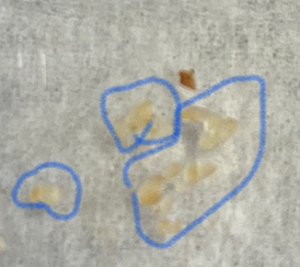
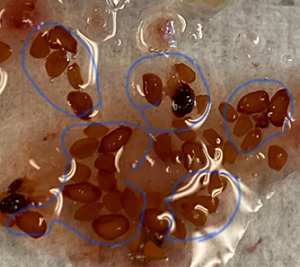
Plant Hormones
Plant hormones play a major role in controlling the process of fruit set, development, and ripening. Hormones such as auxins, ethylene, cytokinins, and gibberellins—many of which are produced by fertilized ovules or developing seeds—influence the early cell division (Stage I) and cell expansion phases (Stage III).
Fruit ripening is mediated by multiple physiological processes that include fruit softening, increase in sugar-to-acid ratio, accumulation of pigments, and flavor development. Ethylene and ABA positively regulate, and auxins negatively regulate, fruit ripening. Blueberries exhibit atypical climacteric ripening physiology. Interestingly, ethylene production is variable among varieties during ripening and during postharvest storage. ABA increases during blueberry fruit ripening. However, more studies are required to understand the role of ABA in ripening initiation as well as its role in fruit-flavor metabolism. Furthermore, the production rate and interaction of hormones such as ethylene, ABA, and auxins are controlled by genetic and environmental factors.
Overcropping
This term refers to a plant that bears more fruit than it can effectively ripen. High-yielding blueberries are genetically programmed to overcrop, producing berries that fail to fully ripen without abscising (Figure 7). Overcropping can decrease fruit size and quality, as well as delay ripening.
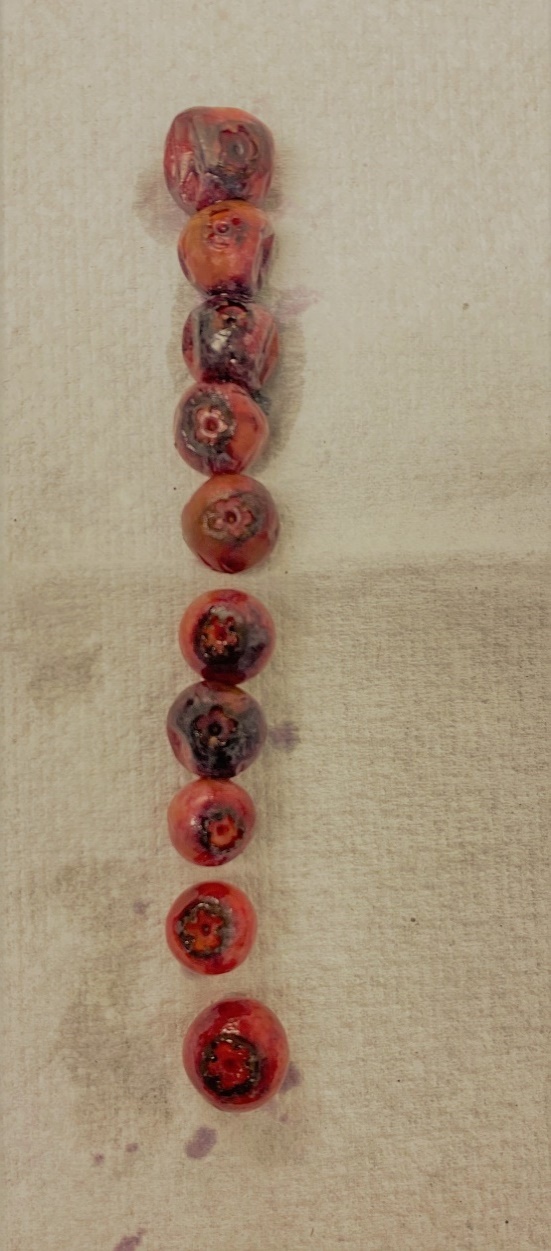
Overcropping can be mitigated by pruning. During pruning, the removal of flower buds can promote fruit set on the remaining buds and speed up ripening. An overcropped plant is an unbalanced plant. It is a plant that has very little foliage (leaves) and too much fruit (shoot-to-fruit ratio). An overcropped blueberry bush will typically have delayed and inconsistent ripening and produce lower-quality fruit (low total soluble solids or Brix) since the plant does not have enough carbohydrates to allocate to the ripening fruit.
Conclusion
Many factors control blueberry fruit set and ripening in each season. Therefore, producers should pay close attention to the environmental factors or stresses that might affect fruit development and ripening in specific varieties, especially after extreme weather events such as freezes. Good fruit quality is the result of proper crop management, appropriate harvesting and handling techniques, and favorable weather conditions—although of course the latter cannot be controlled by producers.
References
Childers, N. F., & Lyrene, P. M. (2006). Blueberries for growers, gardeners, and promoters. Norman F. Childers Horticultural Publications.
Eck, P. (2018). Blueberry. In S. P. Monselise (Ed.), Handbook of Fruit Set and Development (pp. 75–86). CRC Press. https://doi.org/10.1201/9781351073042
Osorio, S., Scossa, F., & Fernie, A. (2013).Molecular regulation of fruit ripening. Frontiers in Plant Science, 4. https://doi.org/10.3389/fpls.2013.00198
Retamales, J. B., & Hancock, J. F. (2018). Blueberries (2nd ed.). CABI.
Tuell, J. K., & Isaacs, R. (2010). Weather during bloom affects pollination and yield of highbush blueberry. Journal of Economic Entomology, 103(3), 557–562.
University of Georgia Center for Agribusiness and Economic Development. (2024). Georgia Farm Gate Value Report 2022 (Report No. AR-24-01). https://caed.uga.edu/content/dam/caes-subsite/caed/publications/annual-reports-farm-gate-value-reports/2022%20Farm%20Gate%20Value%20Report.pdf
Wang, Y.-W., Malladi, A., Doyle, J. W., Scherm, H., & Nambeesan, S.U. (2018). The effect of ethephon, abscisic acid, and methyl jasmonate on fruit ripening in rabbiteye blueberry (Vaccinium virgatum). Horticulturae, 4(3), 24. https://doi.org/10.3390/horticulturae4030024
Zifkin, M., Jin, A., Ozga, J. A., Zaharia, L. I., Schernthaner, J. P., Gesell, A., Abrams, S. R., Kennedy, J. A., & Constabel, C. P. (2012). Gene expression and metabolite profiling of developing highbush blueberry fruit indicates transcriptional regulation of flavonoid metabolism and activation of abscisic acid metabolism. Plant Physiology, 158(1), 200-224. https://doi.org/10.1104/pp.111.180950
Status and Revision History
In Review on May 14, 2024
Published on Jul 30, 2024


























































